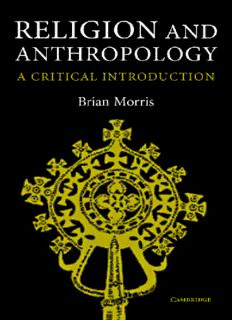
Religion and Anthropology PDF
Preview Religion and Anthropology
religionandanthropology Thisimportantstudyprovidesacriticalintroductiontothesocialanthropologyofreli- gion,focusingonmorerecentclassicalethnographies.Comprehensive,freeofscholastic jargon,engaging,andcomparativeinapproach,itcoversallthemajorreligioustradi- tionsthathavebeenstudiedconcretelybyanthropologists–Shamanism,Buddhism, Islam,Hinduism,ChristianityanditsrelationtoAfricanandMelanesianreligions,and contemporaryNeo-Paganism.Eschewingathematicapproachandtreatingreligionas asocialinstitutionandnotsimplyasanideologyorsymbolicsystem,thebookfollows thedualheritageofsocialanthropologyincombininganinterpretativeunderstanding andsociologicalanalysis.Thebookwillappealtoallstudentsofanthropology,whether established scholars or initiates to the discipline, as well as to students of the social sciencesandreligiousstudies,andtoallthoseinterestedincomparativereligion. Brian Morris is Emeritus Professor of Anthropology at Goldsmiths College, at the UniversityofLondon.HismanypublicationsincludeChewaMedicalBotany(1996), Animals and Ancestors (2000), Kropotkin: The Politics of Community (2004), Insects andHumanLife(2004),andAnthropologicalStudiesofReligion:AnIntroductoryText (Cambridge,1987). Religion and Anthropology A Critical Introduction brian morris UniversityofLondon cambridge university press Cambridge,NewYork,Melbourne,Madrid,CapeTown,Singapore,SãoPaulo Cambridge University Press TheEdinburghBuilding,Cambridgecb22ru,UK PublishedintheUnitedStatesofAmericabyCambridgeUniversityPress,NewYork www.cambridge.org Informationonthistitle:www.cambridge.org/9780521852418 ©BrianMorris2006 Thispublicationisincopyright.Subjecttostatutoryexceptionandtotheprovisionof relevantcollectivelicensingagreements,noreproductionofanypartmaytakeplace withoutthewrittenpermissionofCambridgeUniversityPress. Firstpublishedinprintformat 2005 isbn-13 978-0-511-13532-3 eBook(EBL) isbn-10 0-511-13532-7 eBook(EBL) isbn-13 978-0-521-85241-8 hardback isbn-10 0-521-85241-2 hardback isbn-13 978-0-521-61779-6 paperback isbn-10 0-521-61779-0 paperback CambridgeUniversityPresshasnoresponsibilityforthepersistenceoraccuracyofurls forexternalorthird-partyinternetwebsitesreferredtointhispublication,anddoesnot guaranteethatanycontentonsuchwebsitesis,orwillremain,accurateorappropriate. T oJamesWoodburn Whoguidedmyfirst stepsinSocialAnthropology (cid:2) AdvancePraise: “Brian Morris’ Religion and Anthropology is at once remarkably comprehensive andsituated.Hemanagestoincludemostofthereligiousendeavorsoftheworld andofworldhistorywhilesituatingeachinsocialcontext,elucidatedbyanthro- pologicalfieldwork.Theresultingvolumeisanexcellentresourceforthinkingand teachingaboutreligioninaspecificallyanthropologicalperspective.Iplantoassign thebookformyowncourseonthetopic.” –JamesL.Peacock,UniversityofNorthCarolina,ChapelHill “AsasequelandcomplementtoMorris’spreviousreaderontheoreticalapproaches to religion, this book of impressive scholarship is an admirable success and a thoroughlyenjoyableread.Thebookischaracterizedbyarefreshing,common- sense approach to religion that is eminently accessible due to the consistent avoidanceofunnecessaryjargon,psychobabbleorlyricalprose.Thesympathetic and nonjudgmental ethnographic descriptions, the dynamism of the theoretical polemic,theclearuseofEnglish,andtheeleganceofthenarrativestructuremade this book difficult to put down. A rare experience when reading much modern anthropologicalwriting.” –JeromeLewis,LondonSchoolofEconomicsandPoliticalScience Contents Preface pageix Introduction 1 1 Shamanism 14 1.1 Prologue 14 1.2 WhatIsShamanism? 16 1.3 ShamanismandAlteredStatesofConsciousness 19 1.4 Spirit-PossessionandShamanism 22 1.5 SiberianandInnerAsianShamanism 25 1.6 InuitShamanism 29 1.7 Neo-Shamanism 34 1.8 ComparativeStudies 37 1.9 TheInterpretationofShamanism 40 2 BuddhismandSpirit-Cults 44 2.1 Prologue 44 2.2 TheBuddhistDharma 47 2.3 BuddhismandNatCultsinBurma 54 2.4 BuddhismandSpirit-CultsinThailand 58 2.5 ReligiousChangeinSriLanka 63 2.6 BuddhismandFolkReligioninTibet 68 2.7 BuddhismandtheState 74 3 IslamandPopularReligion 77 3.1 Prologue 77 3.2 TheIslamicTradition 79 3.3 ZarCultsinNorthernSomalia 82 3.4 ZarCultsintheSudan 88 3.5 TheSaintsandScholarsofIslam 96 3.6 TheHamadsha:ASufiBrotherhoodinMorocco 102 3.7 ReligionandPoliticsinMorocco 104 4 HinduismandNewReligiousMovements 112 4.1 Prologue 112 4.2 SanskriticHinduism 115 vii viii CONTENTS 4.3 PopularHinduism 122 4.4 CultoftheGoddess 130 4.5 BhaktiCults 134 4.6 GurusandHinduNationalism 140 5 ChristianityandReligioninAfrica 146 5.1 TheChristianTradition 146 5.2 PrologueonAfricanReligion 148 5.3 TheWorldofKongoBelief 153 5.4 PropheticMovementsinLowerZaire 159 5.5 ReligiousChangeinZambia 164 5.6 ReligiousMovementsinZambia 168 5.7 TshidiBarolongCosmology 177 5.8 ZionistChurchesinSouthAfrica 182 6 African-AmericanReligions 188 6.1 Prologue 188 6.2 VodouinHaiti 191 6.3 VodouRituals 199 6.4 ReligionsofJamaica 206 6.5 TheRastafariMovement 212 6.6 RastafariBeliefsandPractices 217 6.7 ReligionsofBrazil 222 7 ReligionsinMelanesia 232 7.1 Prologue 232 7.2 KwaioReligion 236 7.3 ReligionandEcology 243 7.4 MillenarianMovementsinMelanesia 251 7.5 RoadBelongCargo 257 7.6 TheInterpretationofMillenarianMovements 262 8 NeopaganismandtheNewAgeMovement 271 8.1 Prologue 271 8.2 TheContemporaryNeopaganRevival 273 8.3 TheRootsofNeopaganWitchcraft 278 8.4 PaganPathways 284 8.5 TheWesternMysteryTradition 294 8.6 ContemporaryRitualMagic 298 8.7 NewAgeSpirituality 304 Conclusions 310 References 317 Index 345 Preface I have been teaching a course on the Anthropology of Religion at Goldsmiths’ College,offandon,foralmostthirtyyears.MywritingofAnthropologicalStudies of Religion was in fact motivated by a felt need for an introductory text on the subject,eventhoughIknewthatsomeelitistOxbridgescholarsheldsuchtextsin generaldisdain.Indeed,onewell-knownanthropologistseverelyrebukedmefor even teaching anthropology as a subsidiary subject at Goldsmiths, insisting that anthropologycouldbetaughtadequatelyonlyatapostgraduatelevel.Havingfailed myeleven-plus,Ileftschoolattheageoffifteentoworkinanironfoundry,and, failingtogetintoauniversitybecauseIlackedany‘A’levels,Ihavealwaysfound suchelitistattitudesquitedeplorable.When,alongwithJaneHoyoftheUniversity ofLondonExtra-MuralDepartment,IinitiatedaCertificateofAnthropology,sup- portedbymycolleaguesatGoldsmiths’College,Ifoundgreatdifficultyinconvinc- ingmyanthropologicalcolleaguesatotheruniversitiesthatthecertificatehadany valueasanaccesscourse.Typically,morethanadecadelater,whenacademicshad discovered that anthropology was being widely taught outside of universities, a resourceguidewaspublished,DiscoveringAnthropology,thatcompletelyignored theseearlierinitiatives.Itisworthnotingalsothat,becauseoftheseelitistattitudes, anthropologyistheonlyuniversitydisciplinethatisnotapartoftheschoolcur- riculum,eventhoughBritainisamulticulturalsociety!Unlikesomepretentious academics,ensconcedinsomeeliteuniversity,Ihavealwaysfoundintroductory textsextremelyusefulasteachingaids,inthesamewayastravelguidesareuseful inexploringthelandscape,andtruescholars,likeErnstMayr(forexample),do notfeelthatthewritingandtheuseofintroductorytextsisintheleastdemeaning. Infact,someintroductorytextsoffermorecriticalinsightsintothesubjectmatter thanmanyarticlesinacademicjournalswhereobscurantist,neo-Baroquejargon isoftenacoverforsociologicalplatitudes.Ithusmakenoapologyforofferinga sequelandanupdateofmyearliertext,andithasthesamepurpose,namely,tobe ahelpfulguidetoanthropologicalstudiesofreligion–comprehensive,stimulating Ihope,critical,sympathetic,andaboveall,readable,thatis,freeofobscurantist jargon.Itwill,Itrust,appealtoallstudentsofanthropology,whetherestablished scholarsorinitiatesonaccesscourses,aswellastothestudentsofthesocialsciences generally,andtoallthoseinterestedincomparativereligion. ix
Description: